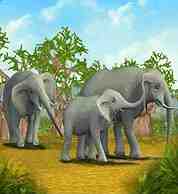AnimalID
Name

5000
African Elephant
LocationName:
Africa
Origin:
Original ZT
PurchaseCost:
$2,500
RequiresResearch:
No
IsClimber:
No
IsJumper:
Yes
|
AnimalID |
Name |
|
|
5000 |
African Elephant |
|
|
LocationName: |
Africa |
|
|
Origin: |
Original ZT |
|
|
PurchaseCost: |
$2,500 |
|
|
RequiresResearch: |
No |
|
|
IsClimber: |
No |
|
|
IsJumper: |
Yes |
|
The Life Cycle |
Who do they like? |
Who do they eat? |
|
The native habitat of the elephant is the open savannah of central and southern Africa. In the wild, elephants occupy a wide geographic range, often traveling many miles in a single day. In captivity, elephants need relatively large spaces in which to live and move about. The more elephants, the more space they need. Elephants are generally found in regions containing wide swaths of tall grasses broken by the occasional stands of acacias and the large African baobab tree, which the elephants like to use for shade. Areas of dirt and sand near waterholes form cool mud holes for the elephants to wallow in, and the occasional large rock provides a perfect scratching post for removing dried mud. Elephants are herbivores, eating various grasses, hay, and even trees. They eat frequently, which is not surprising, given their enormous size. Their long, flexible trunks allow them to reach down to pull up tall grasses as well as to reach up to pull down tasty branches inaccessible even to a giraffe. In captivity, they are fed a variety of foods, including hay, browse (e.g., acacia, corn stalks, bamboo, mulberry, and ficus), apples, bananas, carrots, yams, bran, and herbivore pellets. Elephants are social animals. Although they are often found in groups of up to 25 individuals in the wild, keeping great numbers of elephants in a zoo setting would tax even the wealthiest of zoos. In captivity, groups of two to six individuals are more common. Elephants can quickly become upset when they don't have enough contact with others of their own kind. An angry or upset elephant will make its familiar loud trumpeting sound. Their highly social nature means that one angry elephant can quickly upset the rest of the herd. Elephants are hardy animals that don't often get sick. When they do, their strong constitutions enable them to weather the illness a relatively long time before it becomes life-threatening. Elephants reproduce poorly in captivity. As the largest land mammals in the world, elephants can afford to feel relatively safe in the wild, at least from other animals. In general, elephants only tolerate their own kind. While they have nothing to fear from even the largest predators, they still become very uneasy when placed in close proximity to these animals. Even non-predatory buffalo and rhinos can make elephants uncomfortable. |
||||
|
Attractiveness Adult: |
Attractiveness Young: |
Initial Happiness: |
Habitat Preference: |
Captivity: |
|
50 |
150 |
50 |
65 |
10 |
|
The Life Cycle |
Who do they like? |
Who do they eat? |
|
Min |
Number of Animals/Exhibit |
Max |
||||||||||||||||||||||
|
50 |
2 |
|
6 |
|||||||||||||||||||||
|
Terrain Name |
Value |
1 |
2 |
3 |
4 |
5 |
6 |
7 |
8 |
9 |
10 |
|||||||||||||
|
Savannah grass |
65 |
33 |
65 |
98 |
130 |
163 |
195 |
228 |
260 |
293 |
325 |
|||||||||||||
|
Fresh water |
15 |
8 |
15 |
23 |
30 |
38 |
45 |
53 |
60 |
68 |
75 |
|||||||||||||
|
Sand |
10 |
5 |
10 |
15 |
20 |
25 |
30 |
35 |
40 |
45 |
50 |
|||||||||||||
|
Dirt |
10 |
5 |
10 |
15 |
20 |
25 |
30 |
35 |
40 |
45 |
50 |
|||||||||||||
|
2 |
4 |
8 |
12 |
16 |
20 |
24 |
28 |
32 |
36 |
40 |
||||||||||||||
|
3 |
2 |
3 |
5 |
6 |
8 |
9 |
11 |
12 |
14 |
15 |
||||||||||||||
|
Elevation |
0 |
0 |
0 |
0 |
0 |
0 |
0 |
0 |
0 |
0 |
0 |
|||||||||||||
|
Exhibit Size |
100 |
50 |
100 |
150 |
200 |
250 |
300 |
350 |
400 |
450 |
500 |
|||||||||||||
|
The Life Cycle |
Who do they like? |
Who do they eat? |
|
Value |
Tree Name |
Foliage Effect |
|
|
7057 |
12 |
Baobab Tree |
15 |
|
7056 |
3 |
Yellow Fever Tree |
6 |
|
The Life Cycle |
Who do they like? |
Who do they eat? |
|
Value |
RockName |
Swims |
Only Swims |
walkable By Tall |
Rock |
Rock Effect |
|
|
9206 |
3 |
Small Rock |
1 |
0 |
1 |
1 |
12 |
|
9205 |
3 |
Medium Rock |
1 |
0 |
1 |
1 |
12 |
|
9200 |
6 |
Large Rock |
1 |
0 |
1 |
1 |
6 |
|
The Life Cycle |
Who do they like? |
Who do they eat? |